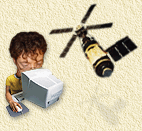
| Print this page - use Landscape |
Search the WeetHet Pages |
|||
| WeetHet is being updated! - Current articles will slowly move to www.tweaking4all.com For excellent webhosting that is reliable and affordable, we highly recommend: LiquidWeb |
||||
|
On this page ...
A hint ... A small note before we continue (since a lot of "smart" salesmen think to outsmart you): EVERY DVB-CARD HAS A MAC-ADDRESS! No matter what they might say about the competition! (check out the Troubleshooting page). Card category DVB cards, like I said before, come in many shapes and colors; 1. Internet by Satellite only cards. These cards are not suitable for watching TV. Using
the DVB note on these cards is slightly misleading for the card buyer.
Often these cards are cheaper. Some examples: Harmonic Cyberstream SAT-1 and the Pentamedia Pent@NET. 2. Internet and TV receivers without a decoder. These cards earn the DVB logo. They are suitable for TV reception and for Internet by Satellite. The TV station you can recieve are so called Free-to-Air stations and (on the Astra) are often german or french. Some of these cards have additional software for harddisk recording of video and Teletext (used a lot in Europe). Some examples: Note: some creative people on the Internet created an application called "MultiDec" which enables you to see pay-TV without additional hardware. This application is working with the Hauppauge/Technotrend cards! 3. Internet and Televisie receivers with decoder. These are the same cards as the once in category 2, extended with a so called CI-module (Common Interface) which offers a PCMCIA-look-a-like slot for a decoder card. In this decoder-card you can put a smart-card for decoding pay-TV stations, for example Canal+. Note: encryption of Canal+ (and other Pay-TV stations) can ONLY be done using a CI-module. Note: the earlier mentioned software solution "MultiDec" does the same job ... Other differences Besides the functional differences, there is also the
difference in connecting the cards to your PC. In the meanwhile two methods
are available: PCI and USB. I have some trouble believing
that USB can handle the full sat-speed, but hey, nowbody sends me an USB
sample to test this. Besides antenna, Audio/Video input (Pentamedia Pent@VISION) for special effects and Audio/Video output (all receivers in category 2 and 3) for connecting your TV or VCR. Video-overlay, the way TV images are displayed on your PC monitor, cab also be done in multiple ways. This can be done using an external cable mixing both signals (like the Pentamedia Pent@VISION does) or by using the software on your PC which does not require extrenal cables. Downside of the external cable is the loss of video-quality of your Windows desktop (upside: you can connect a second VGA monitor for TV imaging). Downside for the software solution is that it requires additional CPU power (upside: image quality remains perfect if your CPU can handle it). So which card should I buy ? The choice depends on a few factors: - Does the Internet via Satellite demand a specific
card ? - how much money are you willing to spend ? - what do you want to do with the DVB-card ?
- what connectivity are you looking for ? - what TV image quality are you looking for ? - how easy should installation be and what are you
software demands ? - should the card be Linux compatible? - should the card be Windows 2000 or Windows ME compatible?
- what kind of service do you want from the manufacturer
? Conclusion: |
||||

